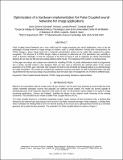Optimization of a Hardware Implementation for Pulse Coupled Neural Networks for Image Applications
Author(s)
Warde, Cardinal; Sarciada, Jesus Gimeno; Rivera, Horacio Lamela
DownloadSarciada-2010-Optimization of a hardware.pdf (319.9Kb)
PUBLISHER_POLICY
Publisher Policy
Article is made available in accordance with the publisher's policy and may be subject to US copyright law. Please refer to the publisher's site for terms of use.
Terms of use
Metadata
Show full item recordAbstract
Pulse Coupled Neural Networks are a very useful tool for image processing and visual applications, since it has the advantages of being invariant to image changes as rotation, scale, or certain distortion. Among other characteristics, the PCNN changes a given image input into a temporal representation which can be easily later analyzed for pattern recognition. The structure of a PCNN though, makes it necessary to determine all of its parameters very carefully in order to function optimally, so that the responses to the kind of inputs it will be subjected are clearly discriminated allowing for an easy and fast post-processing yielding useful results. This tweaking of the system is a taxing process. In this paper we analyze and compare two methods for modeling PCNNs. A purely mathematical model is programmed and a similar circuital model is also designed. Both are then used to determine the optimal values of the several parameters of a PCNN: gain, threshold, time constants for feed-in and threshold and linking leading to an optimal design for image recognition. The results are compared for usefulness, accuracy and speed, as well as the performance and time requirements for fast and easy design, thus providing a tool for future ease of management of a PCNN for different tasks.
Date issued
2010-04Department
Massachusetts Institute of Technology. Department of Electrical Engineering and Computer ScienceJournal
Proceedings of SPIE--the International Society for Optical Engineering; v.7703
Publisher
SPIE
Citation
Sarciada, Jesus Gimeno, Horacio Lamela Rivera, and Cardinal Warde. “Optimization of a hardware implementation for pulse coupled neural networks for image applications.” Independent Component Analyses, Wavelets, Neural Networks, Biosystems, and Nanoengineering VIII. Ed. Harold H. Szu & F. Jack Agee. ©2010 SPIE
Version: Final published version
ISSN
0277-786X
Keywords
PCNN, Image processing, Hardware implementation, Pulse coupled neural networks